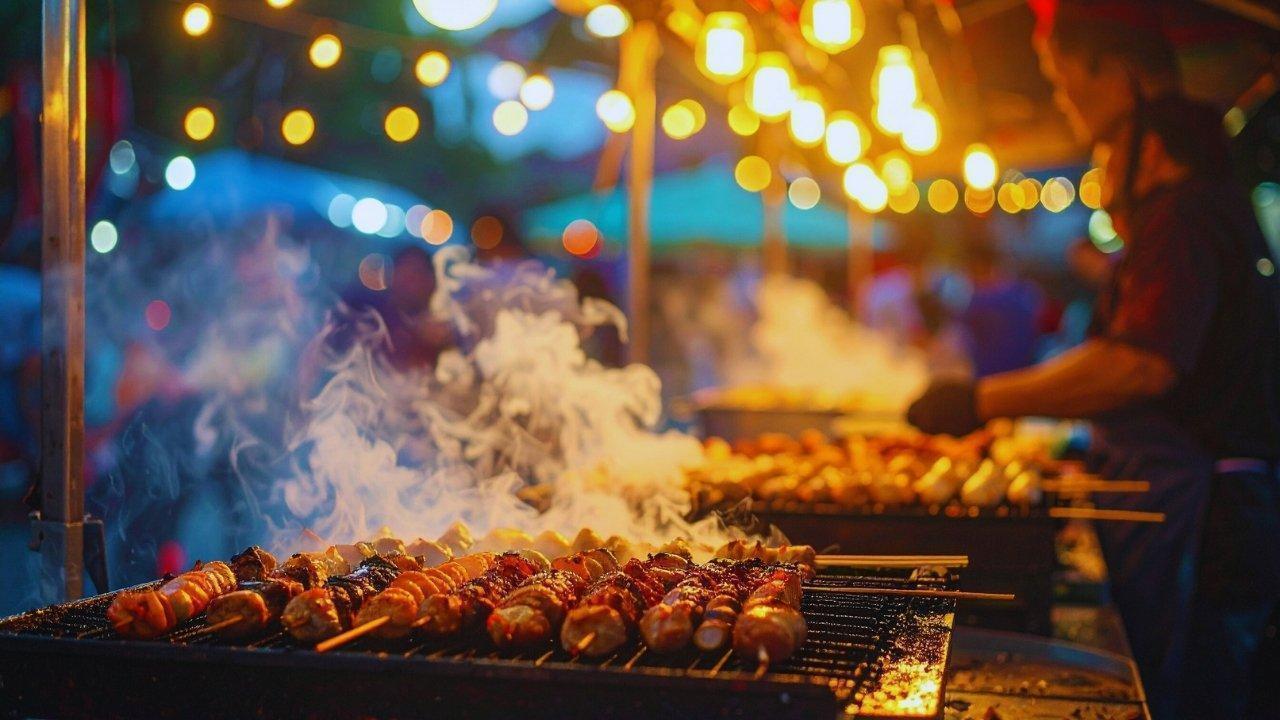
Join 10k+ people to get notified about new posts, news and tips.
Do not worry we don't spam!

Post by : Anis Farhan
Street food in Thailand is more than just a culinary experience — it is an everyday rhythm of life, a cultural identity, and a source of pride. Walk through Bangkok’s bustling streets and you’ll find vendors grilling skewers, frying noodles, or serving spicy papaya salad. For locals, this isn’t simply food; it’s comfort, affordability, and heritage. For tourists, it’s one of the biggest attractions — a gateway to Thailand’s vibrant lifestyle.
But as Thailand moves into a more globalized era, its street food is undergoing a transformation. The traditional stalls, once limited to corners and sidewalks, are adapting to changing regulations, modern expectations, and international opportunities. This evolution raises important questions: Can Thai street food remain authentic while becoming a global trend? Will modernization dilute its cultural essence, or make it stronger?
Thai street food has always been a cultural anchor. Dishes like Pad Thai, Som Tum (papaya salad), and Moo Ping (grilled pork skewers) are not just recipes; they are stories passed down through generations. They reflect Thailand’s history of migration, trade, and regional diversity. Northern Thailand’s dishes are spiced differently from those in the South, reflecting both geography and heritage.
Street vendors have traditionally been family-run businesses, with recipes guarded like treasures. For decades, these stalls have catered to everyone from students and workers to international travelers. They represent social equality in a way — a Michelin-starred chef and a taxi driver might both grab dinner from the same cart. This democratic nature of street food is what makes it so uniquely Thai.
In recent years, Thailand’s government has tried to regulate street vendors in cities like Bangkok. Concerns about hygiene, traffic congestion, and urban aesthetics have led to crackdowns in some areas. Iconic spots where street food thrived have been restricted or relocated.
While some feared this would damage the culture, others saw an opportunity. Many vendors have adapted, upgrading their carts, using better equipment, and adhering to food safety standards. In doing so, Thai street food has become more organized and professional, appealing to both locals and tourists who value cleanliness without compromising on taste.
Still, the balance is delicate. Over-regulation risks removing the charm of spontaneity — the thrill of stumbling upon a hidden food stall down a busy alley. The challenge for Thailand is to preserve authenticity while ensuring safety and sustainability.
Tourism contributes massively to Thailand’s economy, and street food is a major magnet. Travelers often plan their itineraries around food markets, with Bangkok frequently topping lists of the best street food cities in the world. The accessibility, affordability, and authenticity of street dishes are unmatched.
For many, eating street food is not just about taste but about cultural immersion. Sitting on plastic stools at midnight, surrounded by sizzling woks and aromatic spices, creates a sensory memory that no restaurant can replicate.
The government has recognized this, promoting Thai food globally under campaigns like “Thai Select” and positioning it as part of the country’s cultural export. Street food, once seen as local and informal, is now a recognized soft power tool.
The next chapter for Thai street food is innovation. Younger generations of chefs and vendors are experimenting with fusion cuisine, blending traditional Thai flavors with global techniques. Imagine Pad Thai sushi rolls or Tom Yum flavored tacos. While purists may resist, these innovations attract a new wave of consumers, particularly international travelers who crave novelty.
Social media has also amplified this trend. Food bloggers, YouTubers, and Instagram influencers showcase unique stalls, making them overnight sensations. Vendors are no longer just cooks but also content creators. A single viral video can turn a modest stall into a global food destination.
This modern evolution doesn’t erase tradition — instead, it highlights its flexibility. Thai food has always been adaptive, borrowing influences from China, India, and neighboring Southeast Asian cuisines. Fusion, in many ways, is just a continuation of this history.
For many Thais, street food isn’t just culture — it’s survival. Vendors are often small-scale entrepreneurs, running family businesses passed down through generations. Selling food on the street is a path out of poverty for many households.
As modernization arrives, digital platforms are giving these vendors new opportunities. Food delivery apps now list street stalls, expanding their customer base beyond walk-ins. Some vendors have scaled up, turning a single cart into small restaurant chains, all while preserving their signature recipes.
However, challenges remain. Rising food prices, competition from larger chains, and the pressure to maintain quality threaten the sustainability of smaller stalls. The next phase of Thai street food will depend on how well vendors adapt to business demands while retaining cultural authenticity.
Globally, consumers are becoming more health-conscious, and Thai street food is responding. Vendors are offering vegan alternatives, gluten-free options, and reduced sugar recipes. While Thai iced tea might remain iconic, many stalls now provide low-sugar or organic versions to cater to modern health trends.
Sustainability is also a growing concern. Plastic waste from street food packaging has been criticized, leading to eco-friendly initiatives. Vendors are increasingly shifting to biodegradable packaging, metal cutlery, and reusable cups. These small steps make Thai street food more compatible with global sustainability goals.
Thai food is no longer confined to Bangkok’s alleys. Across Europe, the Middle East, and the US, Thai food trucks and pop-up stalls are gaining traction. Dishes like Mango Sticky Rice went viral after a Thai rapper featured it in a music video, showing the cultural crossover potential of street food.
This global recognition opens opportunities for Thai vendors to collaborate internationally. Culinary festivals worldwide now invite Thai chefs to showcase their skills, turning humble recipes into global sensations. As Thai food globalizes, it creates a feedback loop: international demand strengthens local pride, and local innovation fuels global fascination.
Despite its strong global pull, Thai street food faces challenges. Rising urban rents, food inflation, and stricter hygiene regulations may push out smaller vendors. There’s also the risk of commercialization, where international franchises imitate Thai dishes without preserving their authenticity.
If Thai street food becomes too commercialized, it may lose the grassroots charm that made it unique in the first place. Balancing authenticity with modernization will be the defining challenge of the next decade.
The future of Thai street food lies at the crossroads of tradition and innovation. It will remain deeply rooted in its cultural heritage, but modernization, health trends, sustainability, and globalization will shape how it is experienced.
In the coming years, expect to see:
Street food stalls integrating digital ordering and cashless payments.
More eco-friendly practices adopted widely.
Greater fusion with international cuisines.
Government-backed campaigns promoting street food globally.
Vendors expanding from local carts to international food festivals.
Ultimately, Thai street food’s power lies in its adaptability. It has survived wars, economic crises, and modernization waves, all while retaining its identity. Its future will likely be no different — deeply Thai, yet globally celebrated.
This article is for informational and editorial purposes only. It explores cultural, economic, and social perspectives on Thai street food and does not represent official policy positions or endorsements. Readers are encouraged to consult local guidelines and travel advisories for the most accurate updates regarding Thailand’s food culture and tourism.










Conway Shines as New Zealand Edges Out West Indies in Napier
Devon Conway and Rachin Ravindra propel New Zealand to a five-wicket victory over West Indies, clinc

Ja'Marr Chase Faces One-Game Suspension Following Spitting Incident
Bengals' Ja'Marr Chase receives a one-game suspension after spitting on Jalen Ramsey; his appeal has

England Names 12-Man Squad for Opening Ashes Test in Perth
England reveals a 12-man squad for the first Ashes Test in Perth, featuring Shoaib Bashir and a pace

Roger Federer Inducted into Tennis Hall of Fame in Historic First Year
Tennis icon Roger Federer receives Hall of Fame recognition in his first year, alongside renowned co

Steve McClaren Steps Down as Jamaica’s Head Coach Following World Cup Qualifying Draw
After a crucial goalless draw with Curacao, Steve McClaren resigns as Jamaica's head coach, leaving

Daryl Mitchell Tops ICC ODI Rankings, Updates Released
Daryl Mitchell ascends to No.1 in the ICC ODI rankings, with boosts for players from New Zealand, In